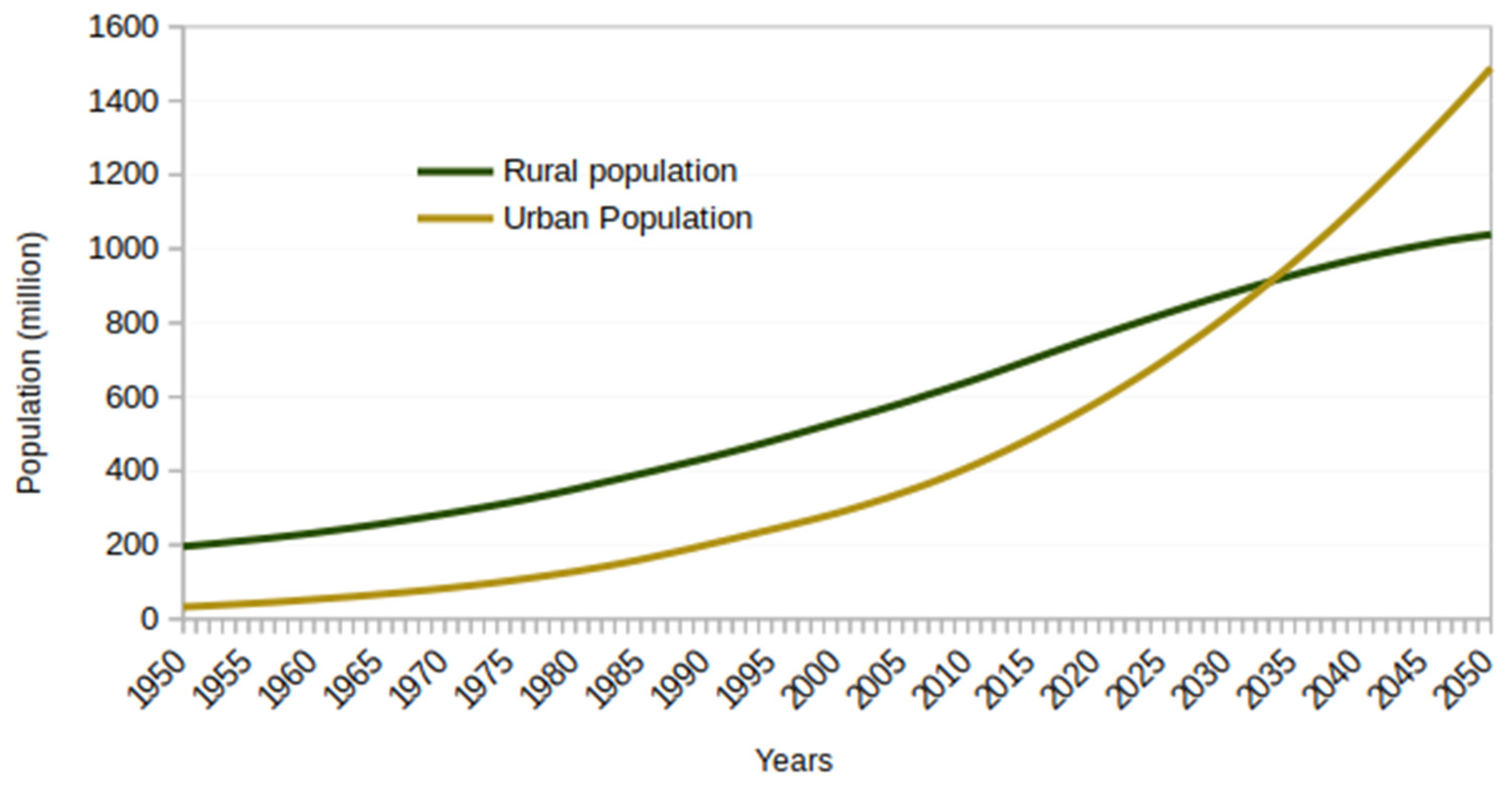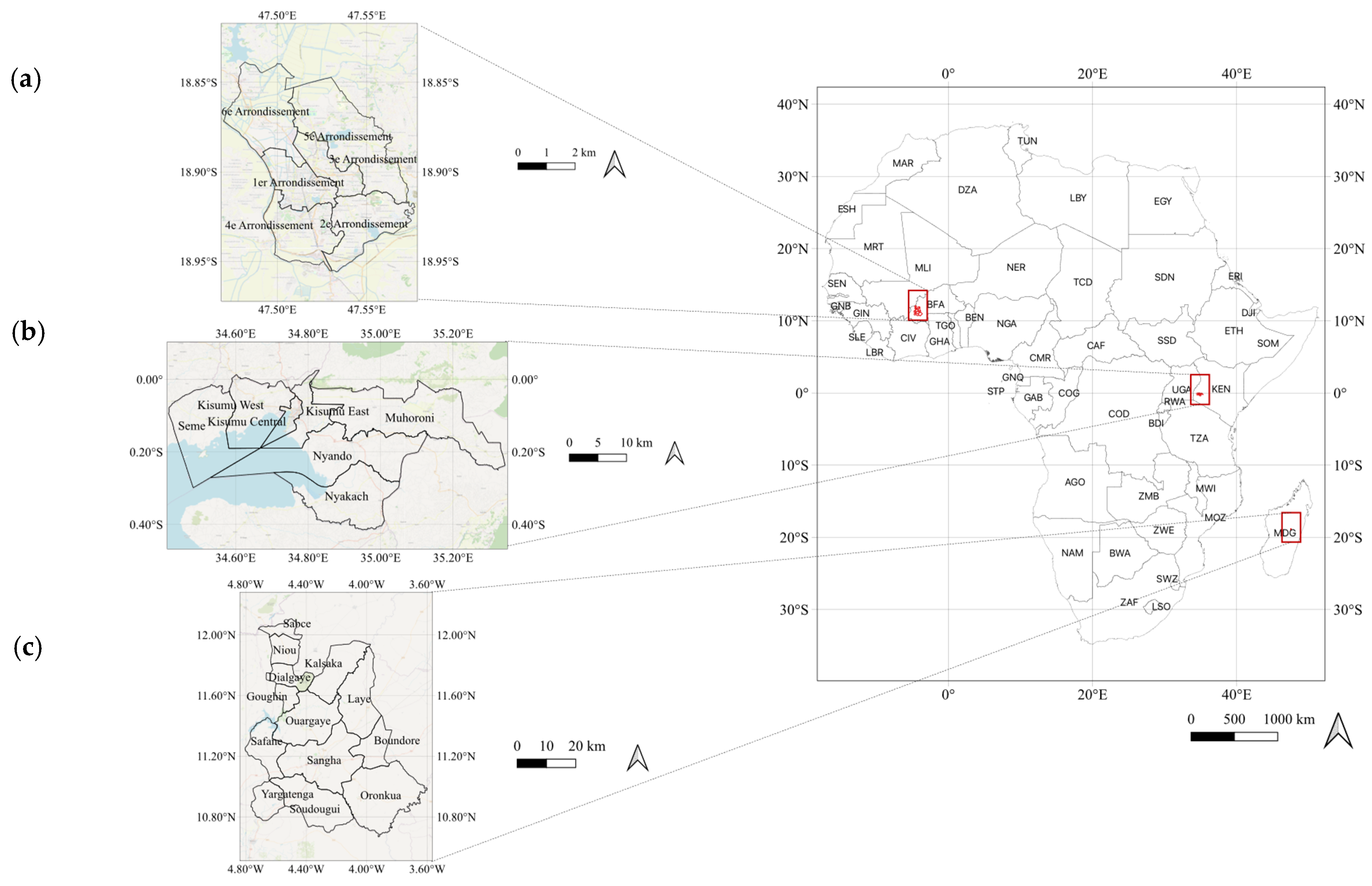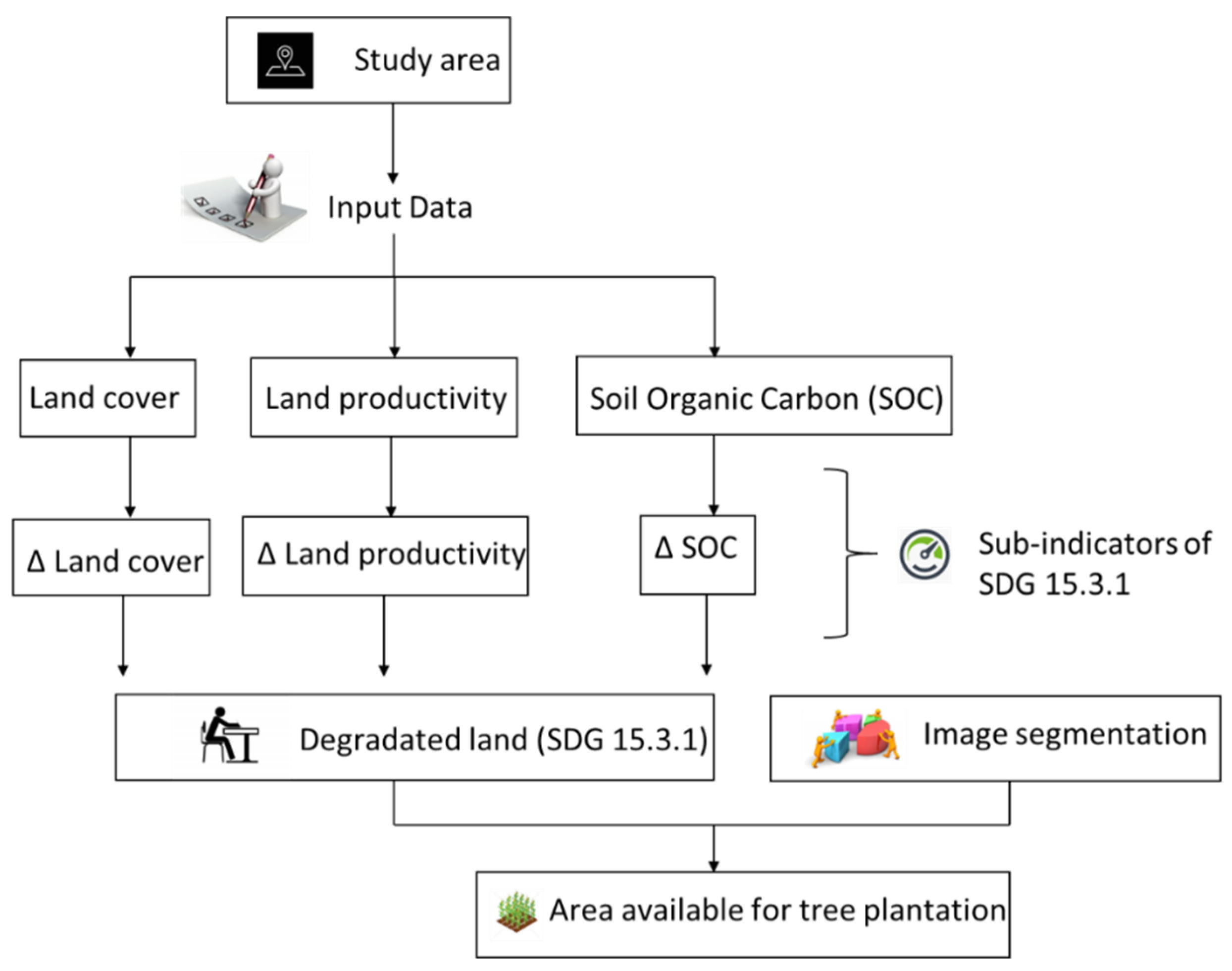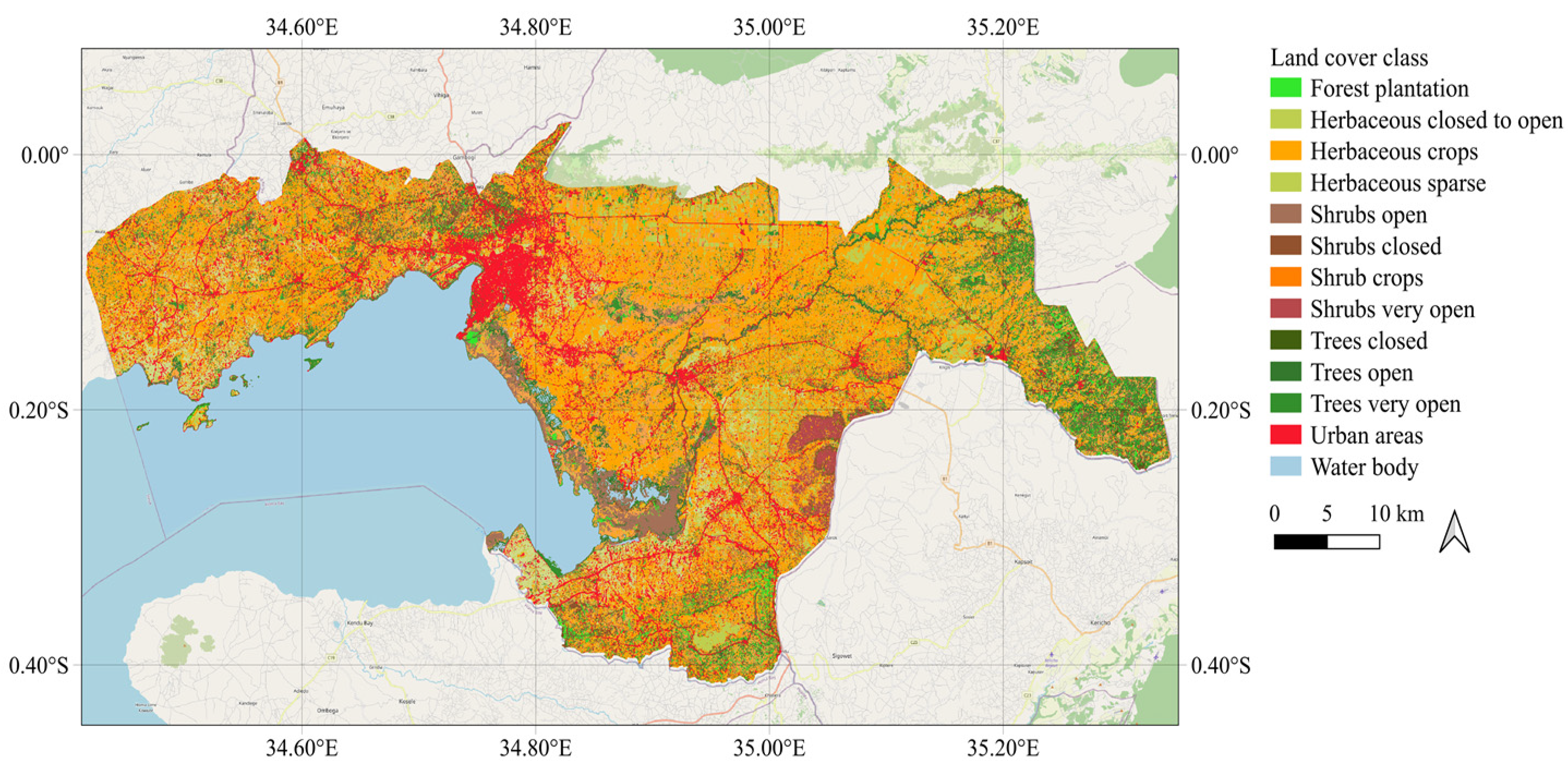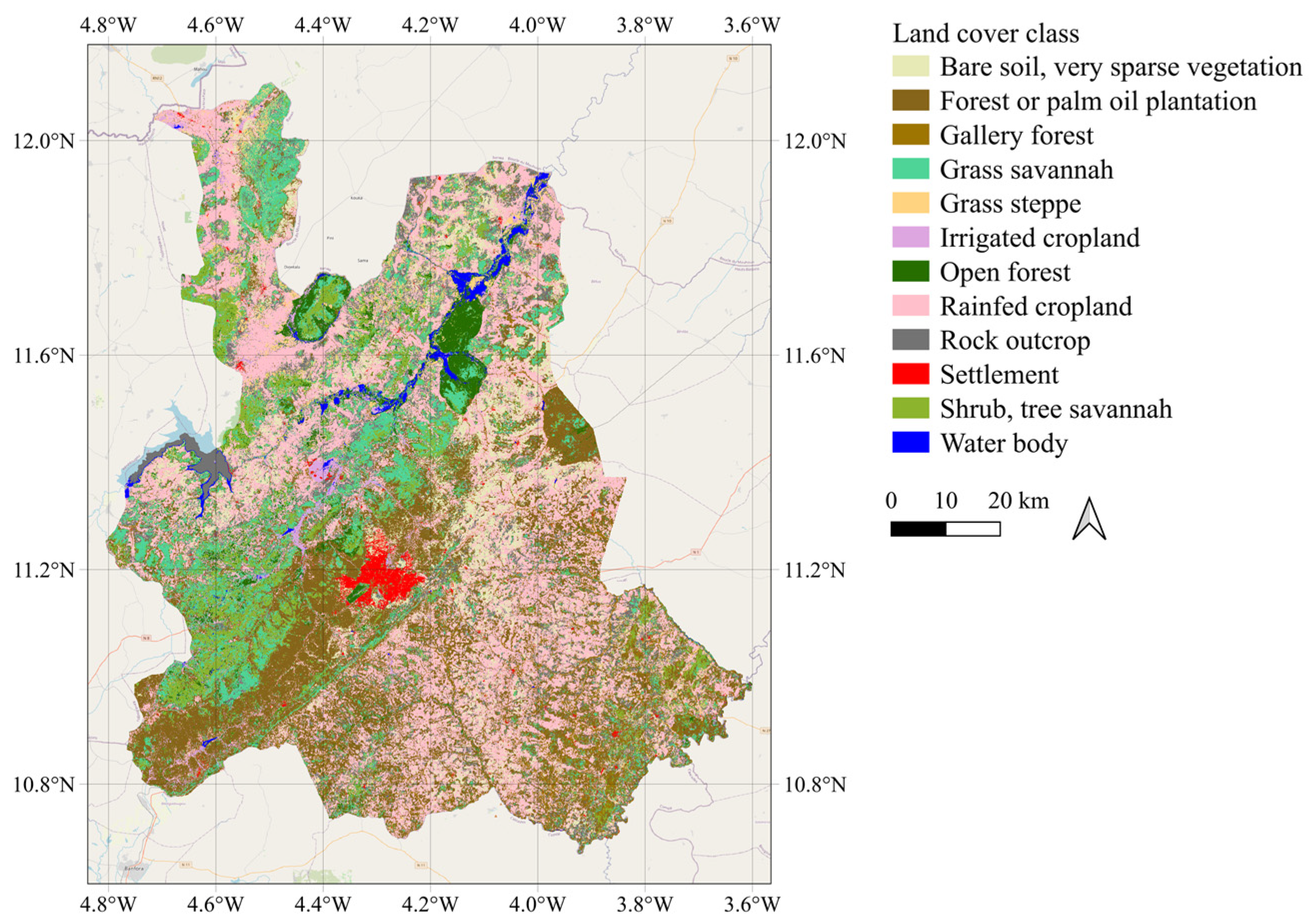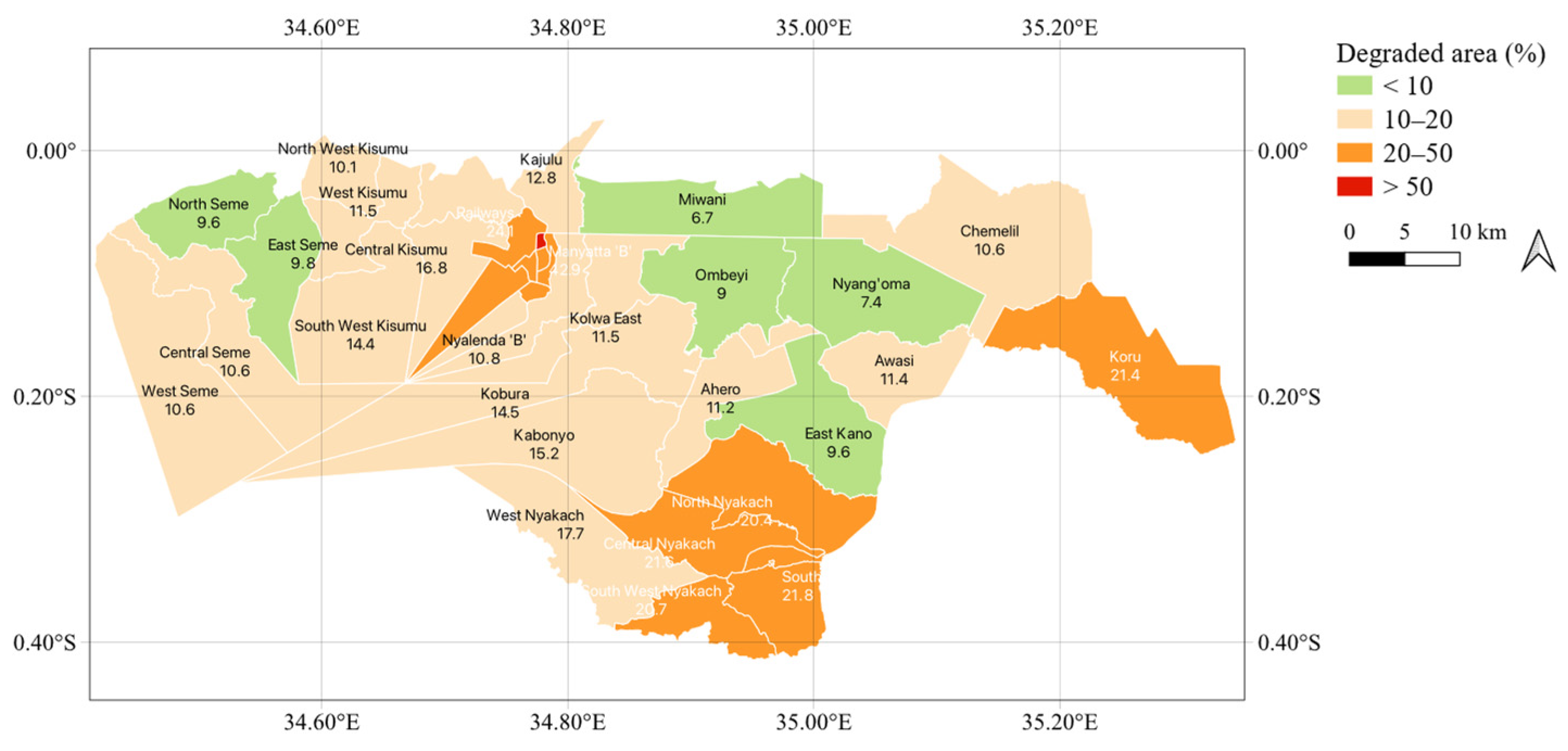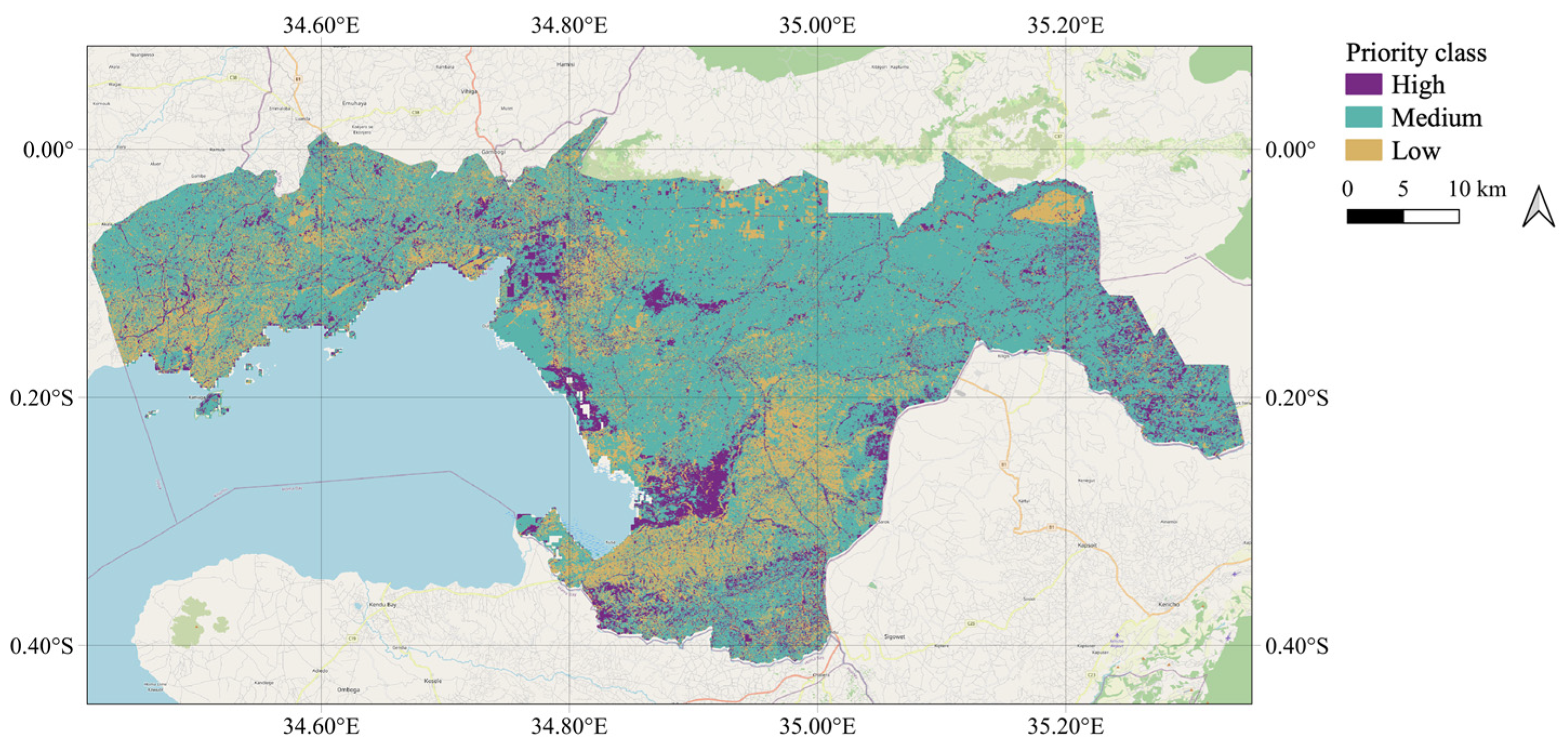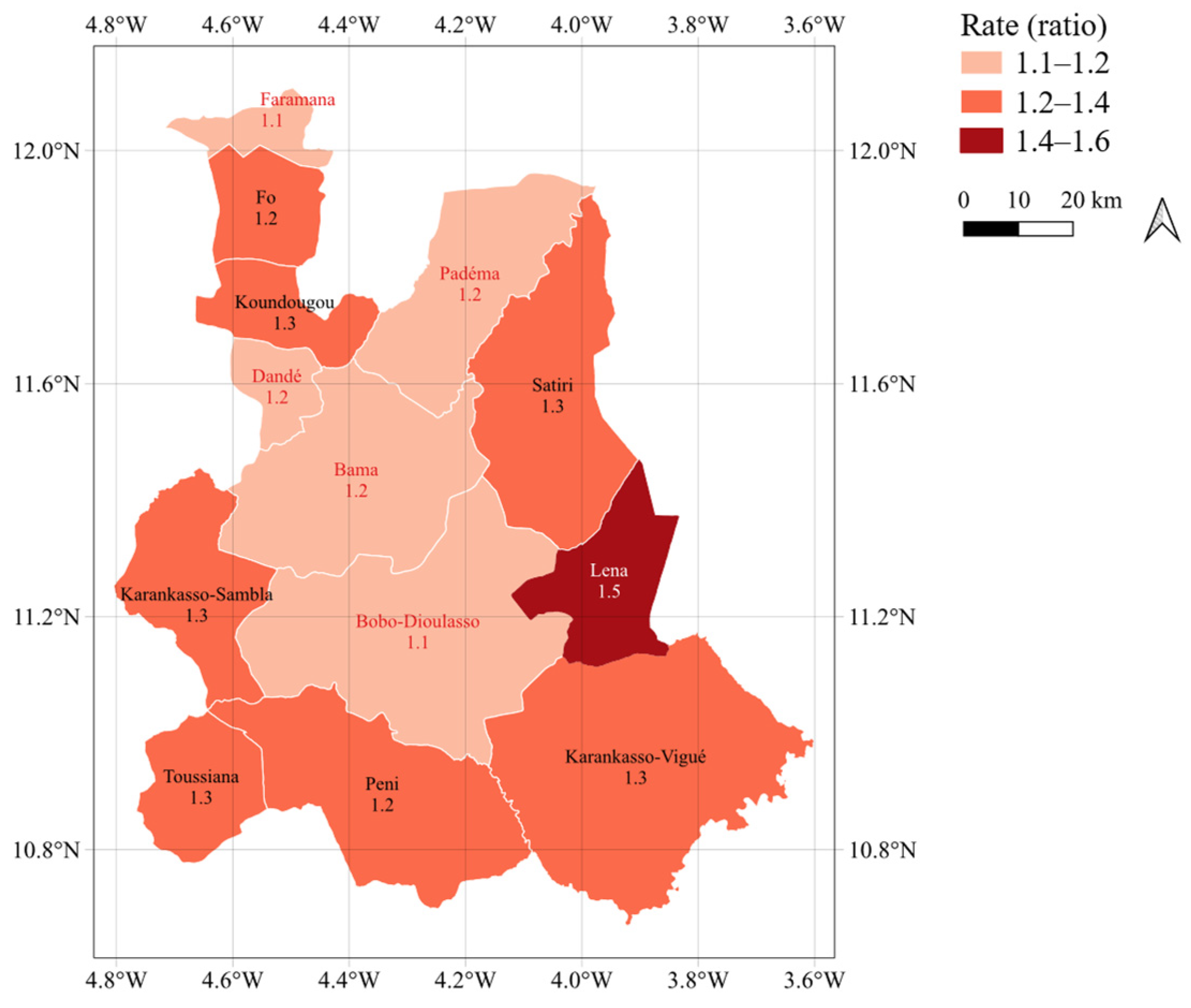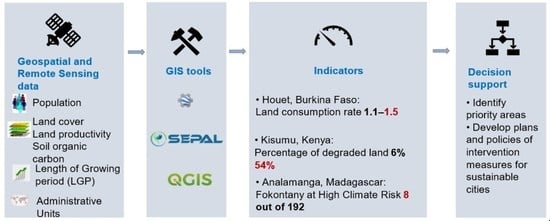1. Introduction
The total population of Africa is increasing rapidly, with the total population almost doubling by 2050, and two-thirds of the population growth is projected to be absorbed in urban areas [
1]. The annual population growth rate from 2010 to 2015 was 1.3% [
2], with that of the world at 1.018% in 2020 [
3]. Furthermore, the urban population in Africa has rapidly grown from 27% in 1950 to 40% in 2015 and is expected to reach 60% by 2050 [
4]. FAOSTAT projects the total urban population to surpass the rural population between 2035 to 2040 (
Figure 1) [
5].
The increase in population in Africa has led to increased competition for food and natural resources. Although evidence of larger yield through limited investments exists [
6,
7], the reduction in crop yield and food insecurity is looming over the region as crop yield has stagnated since the 70s. For example, 153 million people over fifteen years of age suffered from severe food insecurity in sub-Saharan Africa in 2014/15 [
8]. The region also has the lowest per capita income, with sub-Saharan Africa reporting one-third of the average per capita income (PCI) of the world in 2014. The leading cause of food insecurity is associated with limited investment in agriculture, disasters with severe droughts and floods leading to loss of cropland and agricultural areas, insufficient pastures to graze and feed livestock, and traditional and unmechanised farming systems [
8].
The impacts of climate change have a greater impact on the African continent, and the continent’s low and fragile economy further exacerbates the impacts. According to the IPCC AR6 report, agricultural productivity has been greatly impacted by climate extremes and the sector has faced higher economic losses. In addition, a decline in vegetation and enhanced desertification due to climate change is expected. For example, in the Sahara and Sahel, the rainfall is projected to drop, leading to soil degradation and an increase in the frequency of dust storms. As a result, agricultural production is severely affected, which is already reeling under poor irrigation and traditional farming methods [
9,
10]. This has put tremendous pressure on 250 million smallholding farmers who own crop farms of less than five hectares [
11].
Despite being one of the most vulnerable regions globally, climate change studies in East, West and Central Africa are limited. About two-thirds of the land resources in Africa have degraded to a certain degree [
12]. Human activities have led land-use and land-cover changes, resulting in land degradation [
13], and climate change has further increased the risk [
12]. Agriculture and income are the two driving factors behind environmental degradation [
14]. While increasing population leads to environmental damages, a higher income level lowers negative impacts on the environment due to agricultural practices. Agriculture is crucial for the economy of many of the countries in the African subcontinent. Lack of proper land-management practices, natural-resource management and agricultural practices, particularly among farmers with poor economic backgrounds, has further contributed to the region’s environmental and land-degradation problems [
12]. The region’s population is increasing rapidly, which leads to the expansion of agricultural activities to meet the needs of the growing population [
14]. Varying climatic conditions, conflict, war and deforestation are also the driving factors for land degradation in Africa [
12,
14,
15].
Therefore, there is an established need to measure the indicators to better plan for sustainable cities in the wake of climate change, population growth and pressure, and an increase in food demand with limited land resources and productivity. FAO’s four pillars [
16] based on the
four betters aim to transform the agri-food system and make it more efficient, inclusive, resilient and sustainable. First, better production aims at efficient and inclusive agriculture and food supply chains at local, regional and global levels to ensure sustainable consumption and production in the wake of climate change. Second, better nutrition targets end food hunger, attain food security, better nutrition and improved access to healthy diets. Third, better environment’s goal is the sustainable use of ecosystems and resources for agri-food systems and addressing climate change. Lastly, better life focuses on reducing inequalities and encouraging inclusive economic growth.
The main aim of this study is to select three representative indicators—climate risk assessment, land degradation and land-consumption rate—and demonstrate the applicability and feasibility of the selected indicators to better plan for sustainability and greening of cities using global data and tools. First, the climate risk assessment is carried through the change in parameter of length of the growing period. Second, land degradation (SDG 15.3.1) is assessed as a function of change in land cover, land productivity and soil organic carbon. Third, the land-consumption rate (SDG 11.3.1) is derived as a function of changes in urban area and population. The study can be carried out with minimal local data. These indicators are chosen in the framework of FAO’s four betters and address the goals of the four betters. The selected indicators consider climate change, investigate the impacts and pressure of the rapidly growing population on the available resources, increasing food demand and land degradation. The objective of this study is to (a) assess climate risk for the future projected scenarios using the length of the growing period and population data; (b) measure degraded land; and (c) measure the land-consumption rate to demonstrate the applicability of global and open data and tools for the measure of indicators in support to greening and sustainability of cities.
4. Discussion
4.1. Case Study 1: Climate Risk Assessment in the Analamanga Region of Madagascar
For this study, the parameter length of growing period (LGP) is selected to measure the climate risk at the projected (RCP 2.6, RCP 4.5 and RCP 8.5) scenarios from GAEZ data. The LGP data are fundamental to land productivity when temperature and moisture supply facilitate crop growth. Therefore, unlike yield, suitability area and attainable production, which are specific to crop, LGP covers a broad dimension of agricultural production relating directly to agroclimatic potential productivity in days.
The steps and the analysis are simple and easy to formulate to assess the overall risk associated with climate change in agricultural production. Based on the study findings, the cities can be prioritised for high, medium and low risk. This would aid the local authorities in developing better plans and policies for the cities against the impacts of climate change on urban and periurban agriculture. The study also demonstrates the use of global tools and data aggregated at the lower administrative level (here, Fokontany) to prioritise the areas for any planned interventions (such as climate adaptation programmes).
The analysis, however, may not be representative of the impacts in the African continent itself. The regional climate assessment varies considerably within Africa. For instance, in East Africa, the temperature is expected to rise from 0.5 degrees to 3 degrees with an increase in the precipitation and shift in intraseasonal rainfall by 2050 [
49], whereas the temperature is projected to rise from 1.6 degrees to 2.9 degrees by 2050 with reduced rainfall in the extreme west of West Africa [
50]. Such differences in temperature and rainfall patterns are expected to have considerable difference in the agricultural production across the continent.
4.2. Case Study 2: Degraded Land in Kisumu County of Kenya
The study used both global (productivity, SOC) and local data (land cover) to generate the data for measuring the degraded land in publicly available cloud performing tools (GEE and SEPAL). However, the land cover generated following the national land-cover legend is challenging, both with the availability and resolution of data. Therefore, to use the finest (10 m) resolution data for generating land cover, the assessment was carried out using 2016 and 2020 data.
Degraded land is the measure of areas that fail to serve biodiversity, ecosystem services, nutrient cycling and lower production and yield [
51]. Information on degraded land is crucial to identify the hotspots and plan for actions that include the conservation, rehabilitation, restoration and sustainable management of land resources. The measure also helps address the emerging pressures on land to help avoid future land degradation, which is the first step in greening cities and making cities sustainable in terms of equitable use of resources under growing populations and changing climate. The delineation of parcels to derive available land for tree and hedgerow plantation in degraded land is an addition of ancillary data for greening and sustainability of cities through the measure of degraded land.
The present analysis is, however, limited to the assessment through satellite imagery. Deforestation in the form of timber harvesting for large-scale commercial forestry, shifting cultivation and slash-and-burn agriculture are common drivers of land degradation in Africa [
15,
52]. The assessment of degradation through land-cover changes such as conversion of cropland to settlement area may not be as evident as conversion of grassland to cropland through remote-sensing techniques. Further, external forces such as commercial agriculture can play a role in degradation of land, which cannot be directly observed from remote sensed imageries. In addition, the change in land-cover and land productivity in the framework of degraded land is context-specific. The conversion of land as a result of shifting cultivation and large-scale commercial forestry for timber disbalances the overall ecosystem, degrades the overall functioning of the ecosystem and ultimately degrades the land in the long run.
There is also evidence of farmland fragmentation using unmanned aerial vehicles (UAV). In the Qilu Lake watershed of China, UAVs were used to measure the forms, scenarios and drivers of farmland fragmentation and its impact on agricultural production efficiency [
53]. A case study on Rwanda demonstrates that physical drivers of such fragmentation, used as a risk-management strategy, have positive impacts on the nutritional balance for food quality and food sustainability, both being the integral components of food security [
51].
4.3. Case Study 3: Land-Consumption Rate in the Houet Province of Burkina Faso
The study used global data (population data) and local data (national land-cover legend) to derive the land-consumption rate. The latest and finer available data, with 10 m resolution, was used for 2016 and 2020. The satellite imagery was acquired from Sentinel 2 and 100 m population data from Worldpop.
The land-consumption rate measures the physical expansion of the urban area (built-up area) relative to the population growth rate. Cities require an orderly expansion of the urban area to accommodate the internal population growth, migration and provision of the transportation and open-space services. However, the disproportionate physical growth of urban areas relative to population growth leads to inefficient and unsustainable land use that not only results in negative impacts on the environment but also negative consequences in social and economic terms [
51]. Therefore, the measure of the indicator provides an important insight to the city planners about the urban expansion and population growth. The measure of the indicator also adds them in decision making for prioritising the areas for interventions to find a balance between growing population, built-up areas and provision of services (such as transportation and public open spaces).
The interpretation of the indicator, however, may give a dubious meaning. For instance, the ratio of 1 can be associated with both (1) urban compactness and ensuite of delivery of provisional services; and (2) congestions, ill management of urban expansion and deteriorating living standards [
54]. The paper recommends further analysis of the indicator with additional sub-indicators for SDG 11.3.1 and validation of machine-learning results using ground data.
5. Conclusions
Global data and open geospatial tools can be used for climate risk assessment, land-degradation status and land-consumption indicators. The results aggregated at lower administrative levels can be helpful in decision making, preparing and planning the cities in the wake of climate change, food insecurity, population growth and increased urbanisation using simple analysis and through minimal use of local data. Global data and remote-sensing tools can play a vital role in undertaking such studies, especially in countries where local data are scarce and not readily available. Further, the present assessment made use of open satellite imagery (Sentinel, Landsat, NICFI planet) for image classification and fragmentation.
However, the accuracy of the result is challenging for validating the data. The results of this study can be a basis for policymakers in planning an inclusive climate adaptation measure and sustainable land-use frameworks and policies.
The present study selected the Analamanga region in Madagascar for climate risk assessment found eight Falkontany, viz. (1) Soavimasoandro, (2) Androhibe, (3) Ambodivoanjo Ambohijatovo Fara, (4) Analamahitsy Tanana, (5) Amorona, (6) Ambaravarankazo, (7) Alarobia Amboniloha and (8) Ambatobe, are at high risk from climate change. Similarly, in Kisumu county, Kenya, the measure of the land-degradation indicator showed that Migosi, Manyatta’ B’ and Kondele have higher degraded areas than other areas within the county. Therefore, these areas should be prioritised for land restoration and rehabilitation activities. Furthermore, Lena, Karankasso-Vigue and Koundougou departments in Houet province, Burkina Faso, have a higher land-consumption ratio. The findings demonstrate a higher need for intervention to find a balance between expanding the built-up area, accommodating the population and providing basic services (such as transportation and open spaces).
